Background
After searching for a while, I have only found one research on the performance of different categories of cryptos. How do different categories of cryptos perform on the market? What does that mean for blockchain project investors? These have been the questions that inspired me for the past summer.
With the historical trading data from Coin Market Cap and the categorization data from CryptoSlate, I built this online tracking and analysis system, which helped me to track the performance of each crypto category. I will present some of my findings below, while you are more than welcome to use this platform to do more analysis.
Methodology
This database includes all historical transaction data provided by Coin Market Cap from April 2013. A full list of categories and cryptos can be found here.
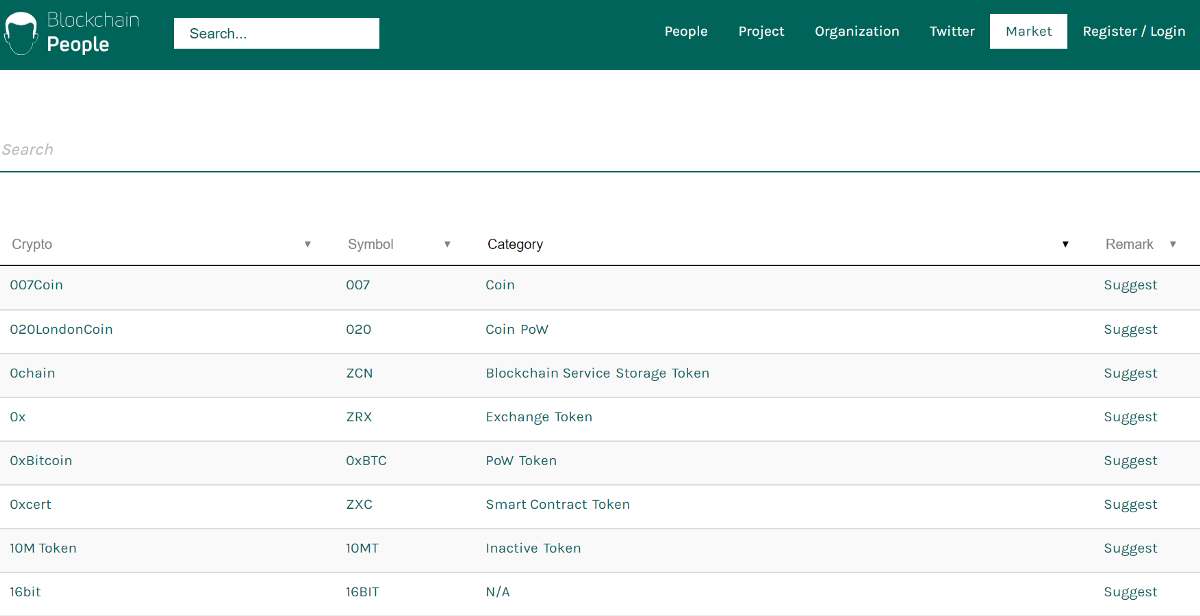
To understand the market’s reaction to/expectation of a specific category of cryptos , several metrics can be considered:
(1) Total Category Market Cap — All Cryptos: this is the first metric that many people will look into. The total market cap reflects how much money has flowed into the market and indicates how positive people feel about this vertical. For example, even the total market cap of all cryptos is decreasing after January 2018, the total market cap of stablecoins is constantly growing, which indicates that the market is still holding a positive attitude towards the future of cryptos as a means of transaction.
(2) Total Category Market Cap — Dominant Cryptos Only: not every crypto equals. For some categories, there can be a very long tail that contributes for less than 5% of this category’s market cap. To filter out the trash cryptos, I selected the dominant cryptos based on the following definition: A crypto is a dominant crypto if it contributes to the top 95% of the total market cap on any date. For example, you can order all cryptos on any date by market cap from the largest to the smallest. Then you accumulate the market cap to 95% of this date’s total market cap. All cryptos that contribute to this 95% market cap on any date are called dominant cryptos.
(3) Average Crypto Market Cap: this is calculated by dividing the total market cap by the number of cryptos in that category. This metric reflects the potential market cap of a new crypto to be launched in that category.
(4) Average Transaction Volume: this is calculated by averaging the transaction volumes of each eligible crypto. This metric reflects the liquidity of a specific category/crypto.
(5) Number of Cryptos: this will reflect where the hypes are and what blockchain applications people are working on.
None of these metrics can tell us a solid future. However, they will help us to understand at least which problems people are most concerned about. For example, the distinctive growth of stablecoins’ market cap indicates that cryptos’ use as a transaction medium was not fully realized before due to their high volatility. For another example, the outstanding performance of privacy cryptos indicates that people believe privacy is an urgent/important issue that should be addressed properly for cryptos.
Findings
1. Exchange, Financial Services, and Privacy are the top three dominant crypto categories
Based on the historical data, as of September 27, 2018, there are 165 dominant cryptos, which once contributed to the top 95% market cap by definition. However, there are 3,317 cryptos since the existence of bitcoin. That being said, roughly speaking, 5% of the cryptos (165) are dominating the 95% market cap. This long tail indicates that most cryptos have little value and that doing analysis on an overall market level will not help that much.
Among the 165 dominant cryptos, 10 are invented for Exchange (e.g. BitShares), 9 are used for Financial Services (e.g. OmiseGO), 9 are focusing on solving Privacy issues (e.g. Monero), 8 are developed for Marketplace (e.g. Populous), 7 from Gaming (e.g. GameCredits), 6 from Computing (e.g. Golem), and another 6 are used as Investing Tools (e.g. Iconomi). The other categories include:
AI (4), Identity (4), Software (4), Social (4)
Entertainment (3), Storage (3)
Advertising (2), IoT (2), Prediction (2)
Blockchain Service (1), Business Services (1), Crowdfunding (1), Debit Card (1), Energy (1), Healthcare (1), Stablecoin(1).
A higher number of dominant cryptos in a category indicates that this vertical is important and promising in the future. On the contrary, a lower number means either that some cryptos accidentally get into the list or that the vertical is highly concentrated (e.g. Stablecoin).
2. Privacy is a big issue
Comparing to all the other categories of cryptos, Privacy has almost always maintained the highest market cap, regardless of dominant/non-dominant cryptos.
As of September 23, 2018, Privacy cryptos have a market cap of about $3.524 billion or 1.53% of the total market cap from 28 cryptos ($3.450 billion from 9 dominant Privacy cryptos).
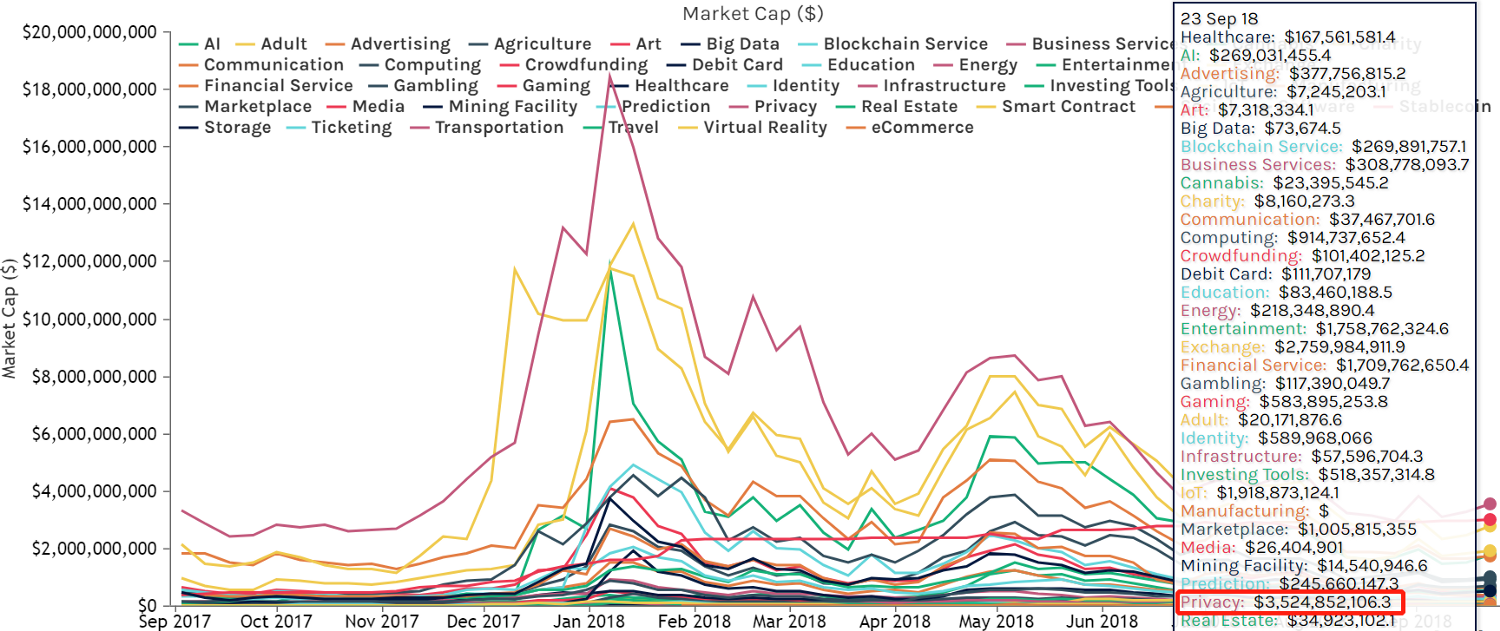
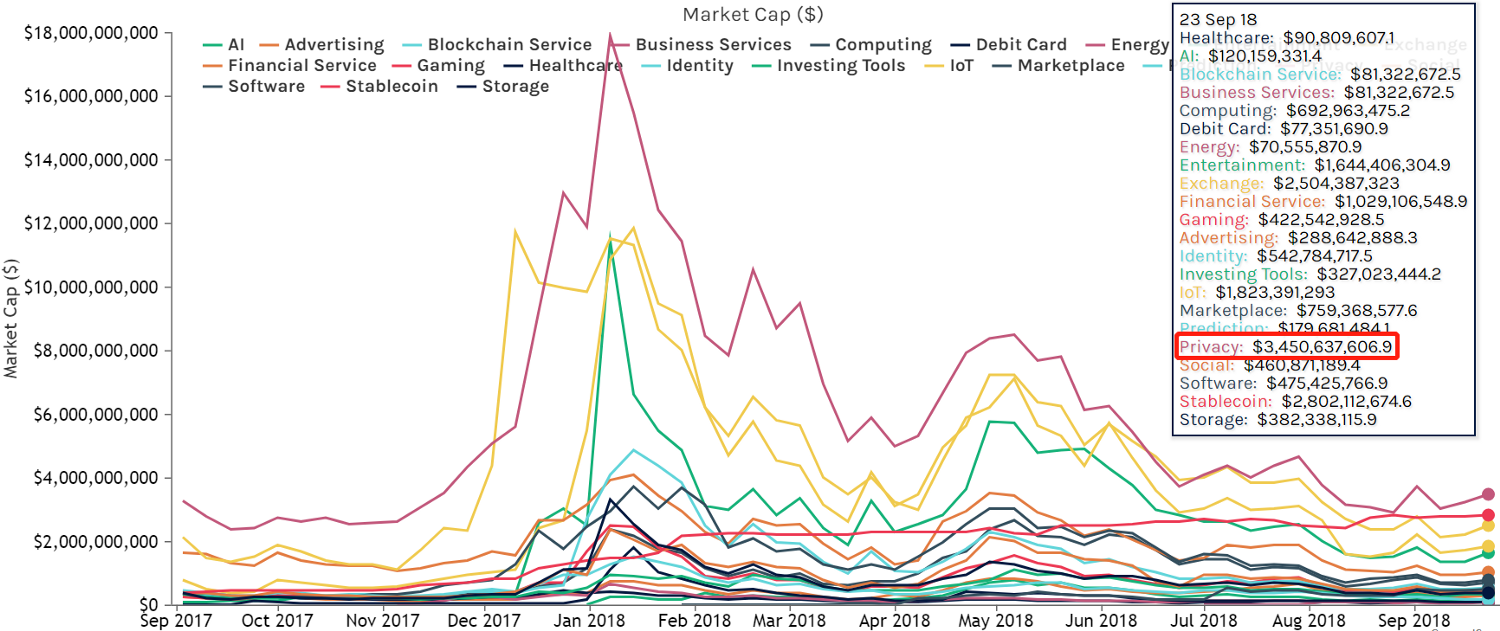
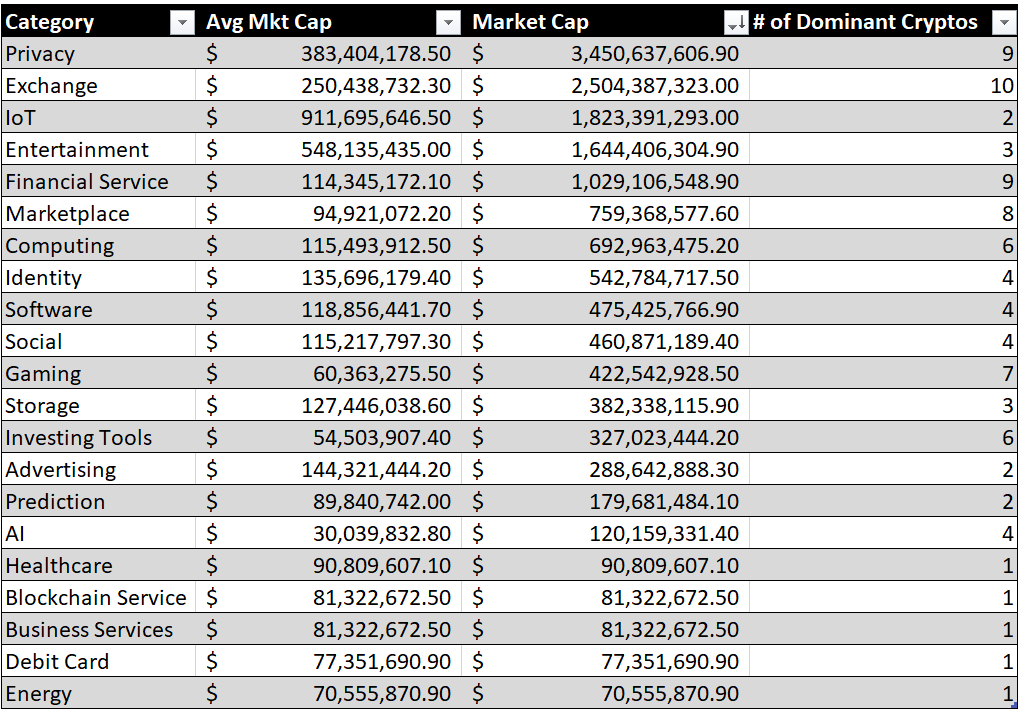
On a crypto level, 9 dominant Privacy cryptos also outperform most of the dominant crypto categories with an average market cap of $383.404 million, which is only lower than IoT ($911.695 million), Entertainment ($548.135 million), and Stablecoin ($2.802 billion). However, IoT (2 dominant cryptos), Entertainment (3 dominant cryptos), Stablecoin (1 dominant crypto) are possibly more concentrated than Privacy. The outstanding performance of these categories can be related to specific projects.
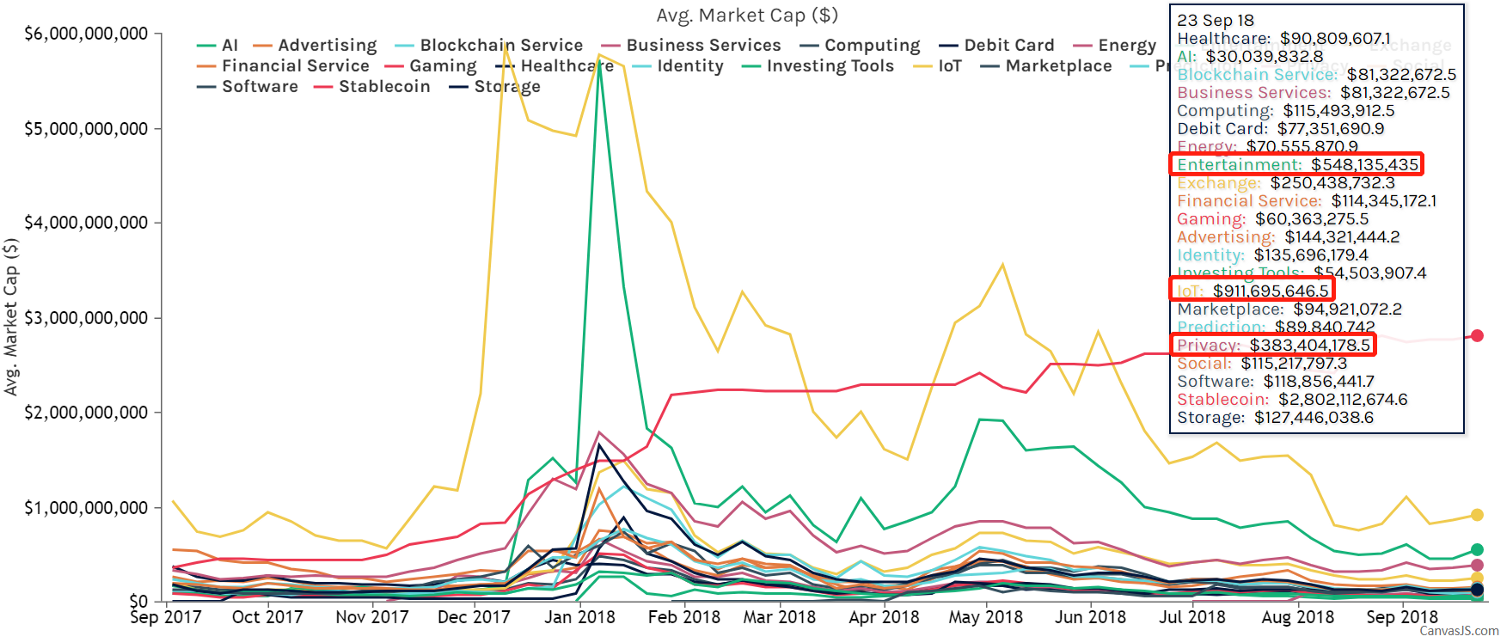
With $1.918 billion and $1.758 billion market cap (including all crytos), which are lower than that of Privacy category, IoT and Entertainment categories have 2 and 3 dominant cryptos respectively. We can then further confirm the concentration of IoT and Entertainment categories since: (1) the total market caps of IoT and Entertainment are lower than that of Privacy; (2) the number of dominant cryptos from these two categories is lower than that from Privacy; (3) the dominant cryptos from IoT and Entertainment have a higher average market cap than that from Privacy.
In the dominant space, IoT and Entertainment cryptos have a higher average market cap. While on the overall market, we can find that the average market cap of Privacy cryptos is higher than that of IoT and Entertainment cryptos. This fact indicates that there are potentially fewer trash cryptos in the Privacy category, and that Privacy cryptos may have a higher chance to get a high market cap than IoT and Entertainment cryptos.
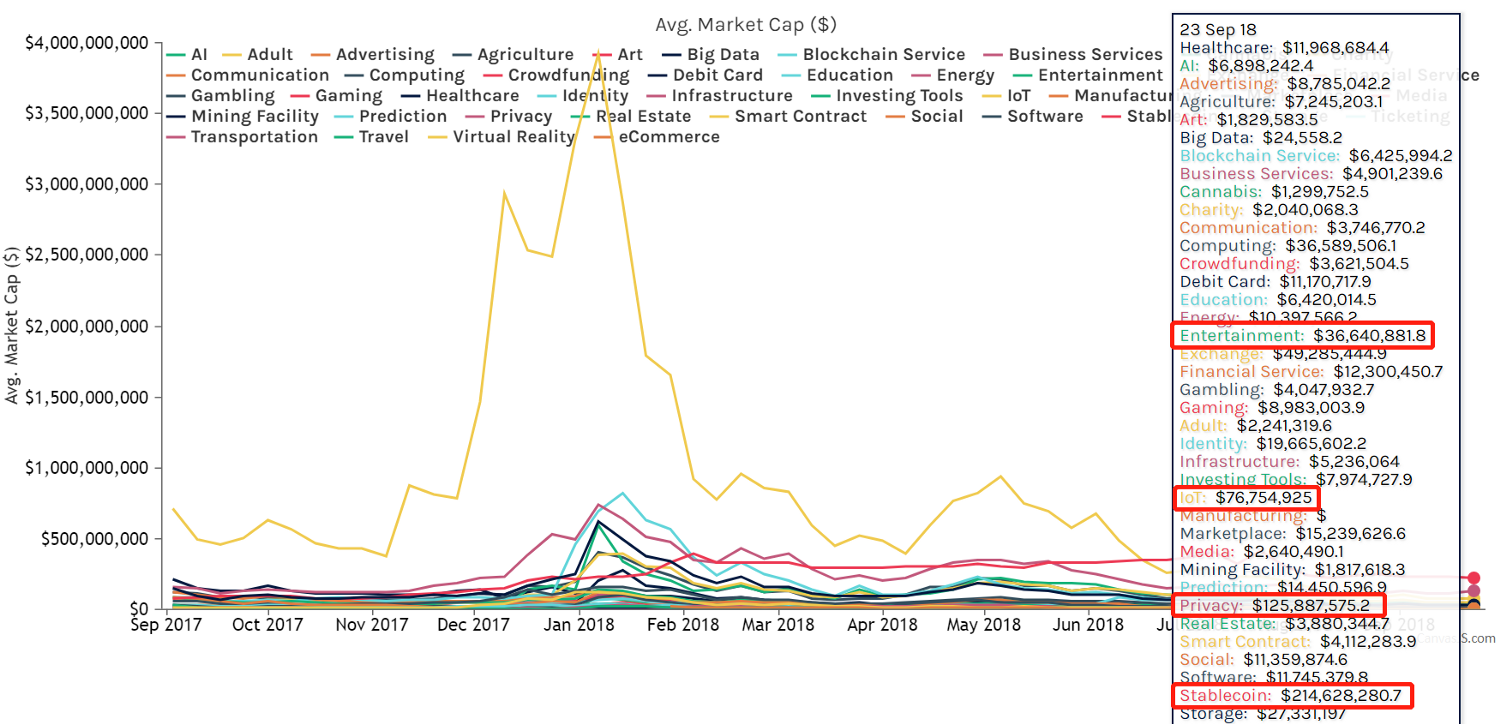
From a transaction perspective, we can also see that Privacy cryptos are outperforming most of the other categories including IoT. The Entertainment cryptos (dominant or non-dominant) have a slightly higher average transaction volume than the Privacy cryptos. However, Privacy category has 28 cryptos with 9 dominant cryptos, while Entertainment category has 48 cryptos with only 3 dominant ones.
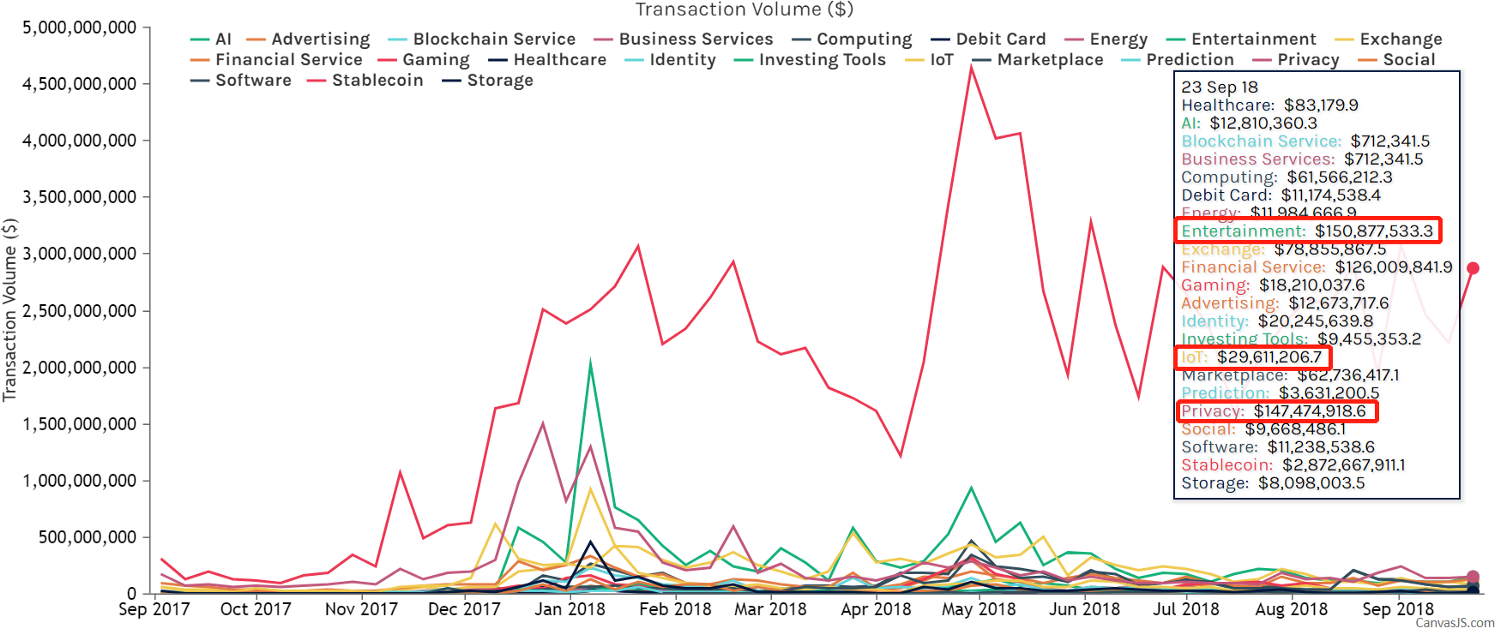
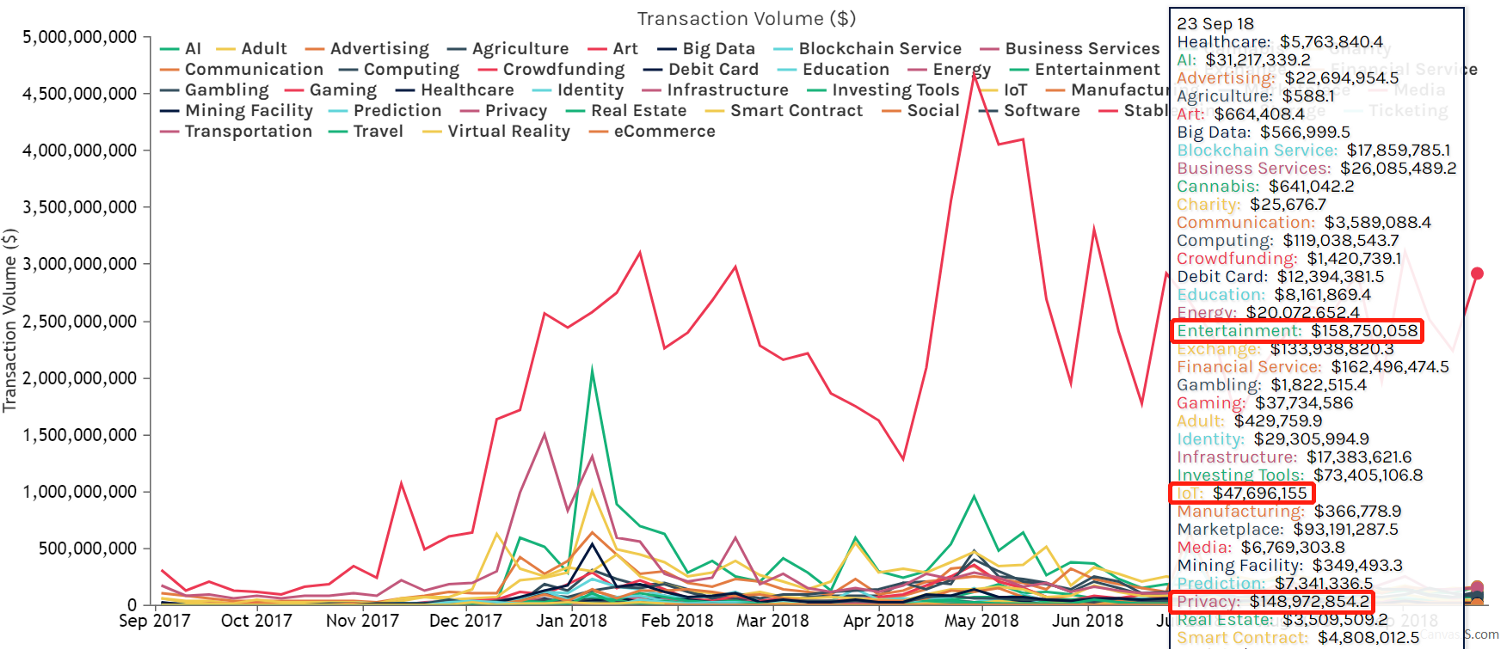
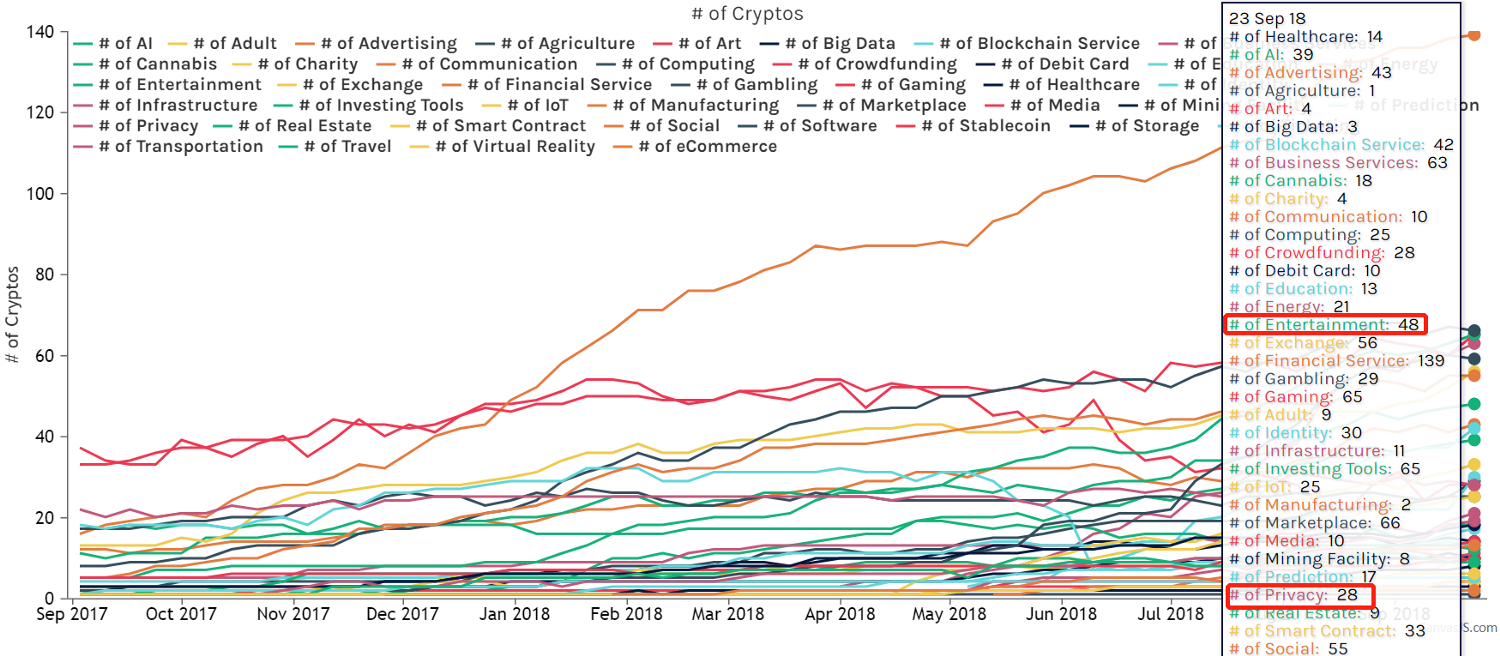
Putting all things together, according to history, we can relatively safely conclude that Privacy cryptos have a higher chance to succeed since:
(1) Privacy cryptos have the highest market cap (dominant and non-dominant);
(2) Privacy cryptos have a high average market cap while not heavily concentrated;
(3) Privacy cryptos have a high transaction volume while not heavily concentrated;
(4) Privacy cryptos have a higher chance to become dominant cryptos.
3. Volatility is being and needs to be addressed
Based on the graphs, we can always find a strange growth in the shrinking market. The market cap of stablecoins has increased 718.94% from September 2017 to $3.004 billion today. Overall, the market cap and transaction volume of other categories are constantly decreasing, while they are almost always growing for stablecoins.
This dramatic growth has clearly indicated that the market needs to address the volatility issue of different cryptos that would be used as a daily transaction tool. Without solving the volatility, no one would like to use currencies like Venezuela Bolivars and Turkish Lira in their daily life.
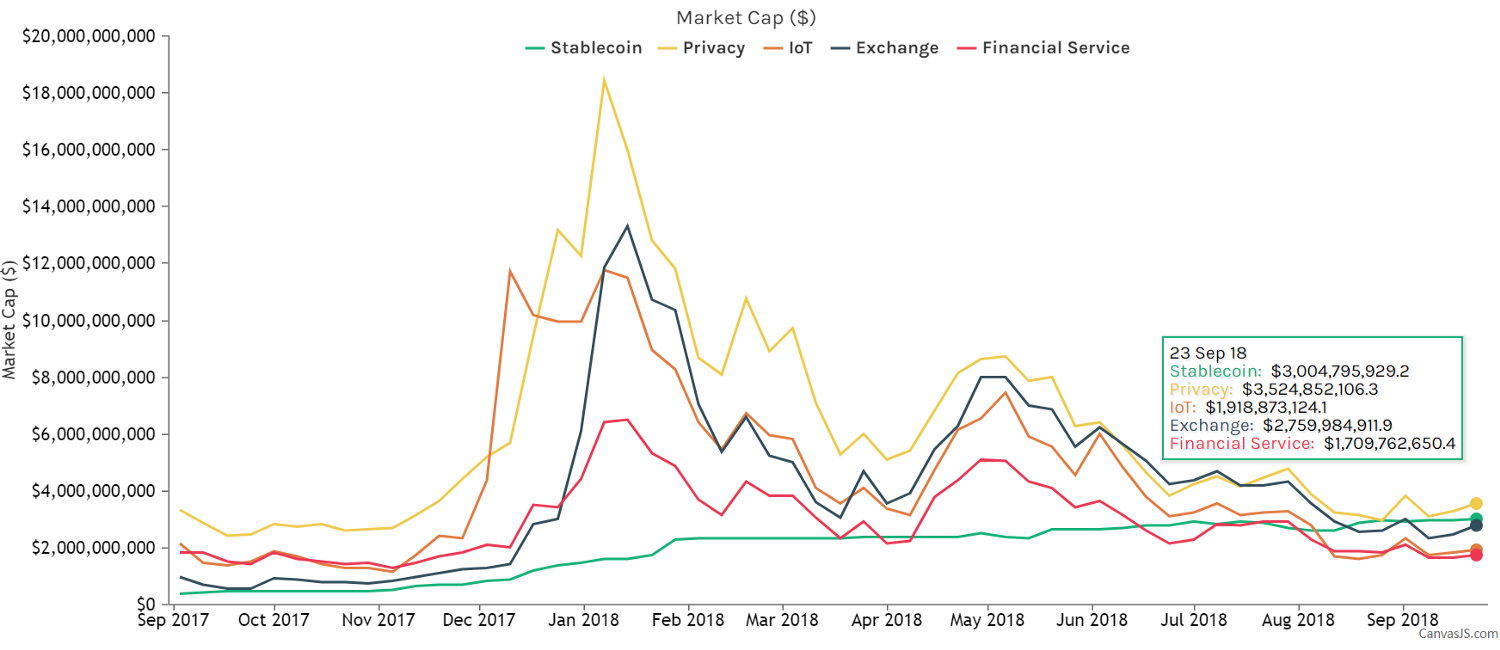
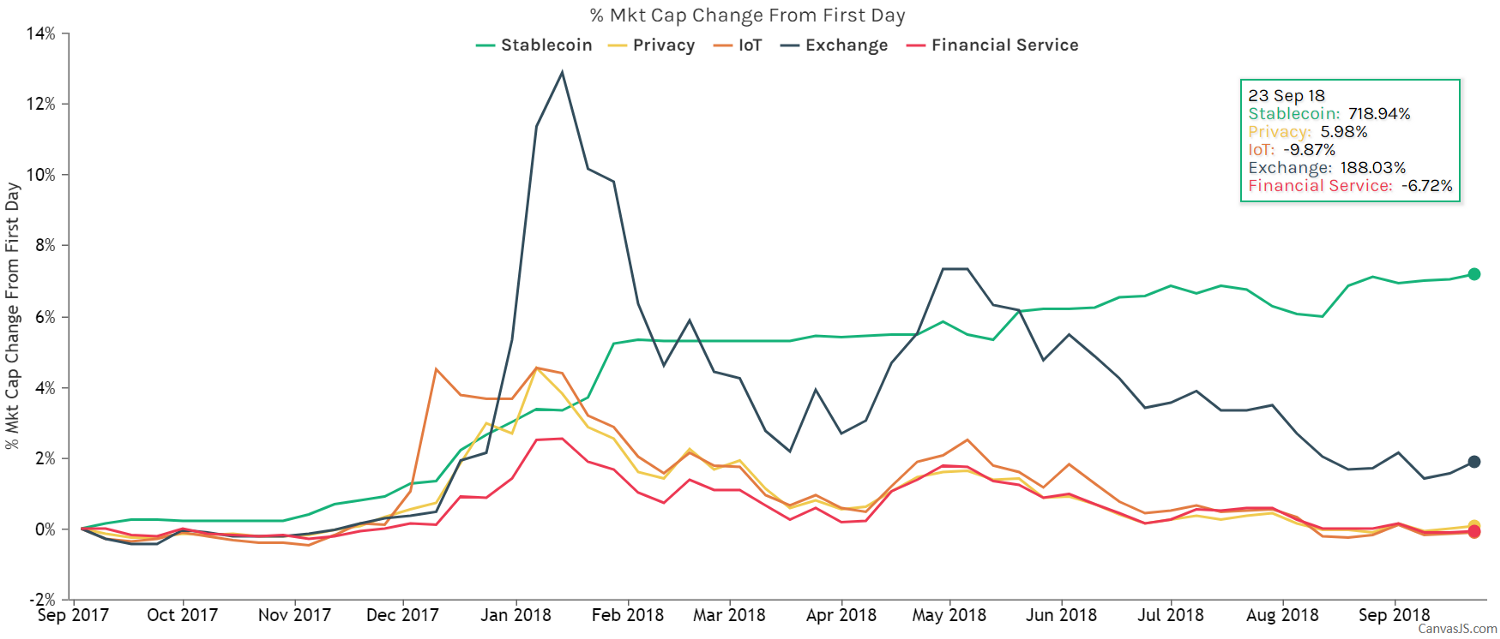
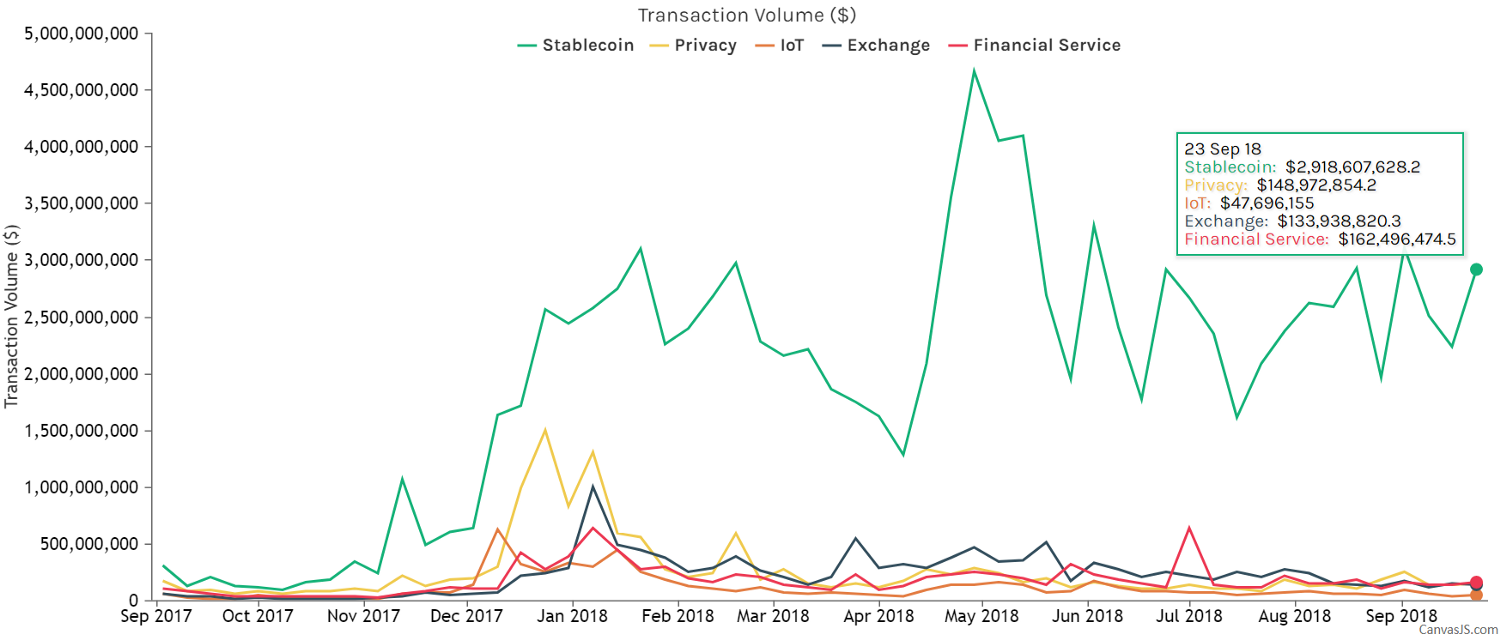
However, there are some unsolved issues around the stablecoins. According to Consensys, the USD-pegged (or Fiat-pegged) stablecoins (e.g. the only dominant stablecoin Tether) has the following limitations:
Centralized: single point of failure, which is an increased source of risks;
No transparency: hard, even impossible, to trust. Also, actual costs and processes are opaque and can involve higher fees and delays due to peaks of demand badly managed;
No guarantee to hold funds nor to redeem tokens;
Collateral Costs: storage, transport, audits, legal, etc.
Moreover, many people even suspect Tether is actually a fractional reserve and don’t hold all of the fiat as they claim they do.
Other than the Fiat-pegged stablecoins, the Crypto-pegged stablecoins and Seigniorage shares stablecoins have even more limitations (see here and here).
The future of Tether is unclear, however, the urgent demand of a reliable decentralized stable crypto currency is already there.
4. Hype/Growth does not necessarily mean opportunities
Generally speaking, growth means opportunities. However, we would only want the healthy growths. A healthy growth of a crypto category is defined as follows:
(1) The overall growth is not resulted from the growth of one or two cryptos;
(2) The growth is not primarily resulted from the increasing number of cryptos.
If we look into the percentage change of market cap from the September 03, 2017, some categories may look really fast-growing and attractive. The AI, Business Services, Entertainment, Mining Facility, Real Estate, and Software categories have achieved a 10X+ growth during the last year in terms of market cap. Even when you look into the average market cap change of cryptos in that category, you will come to the same conclusion.
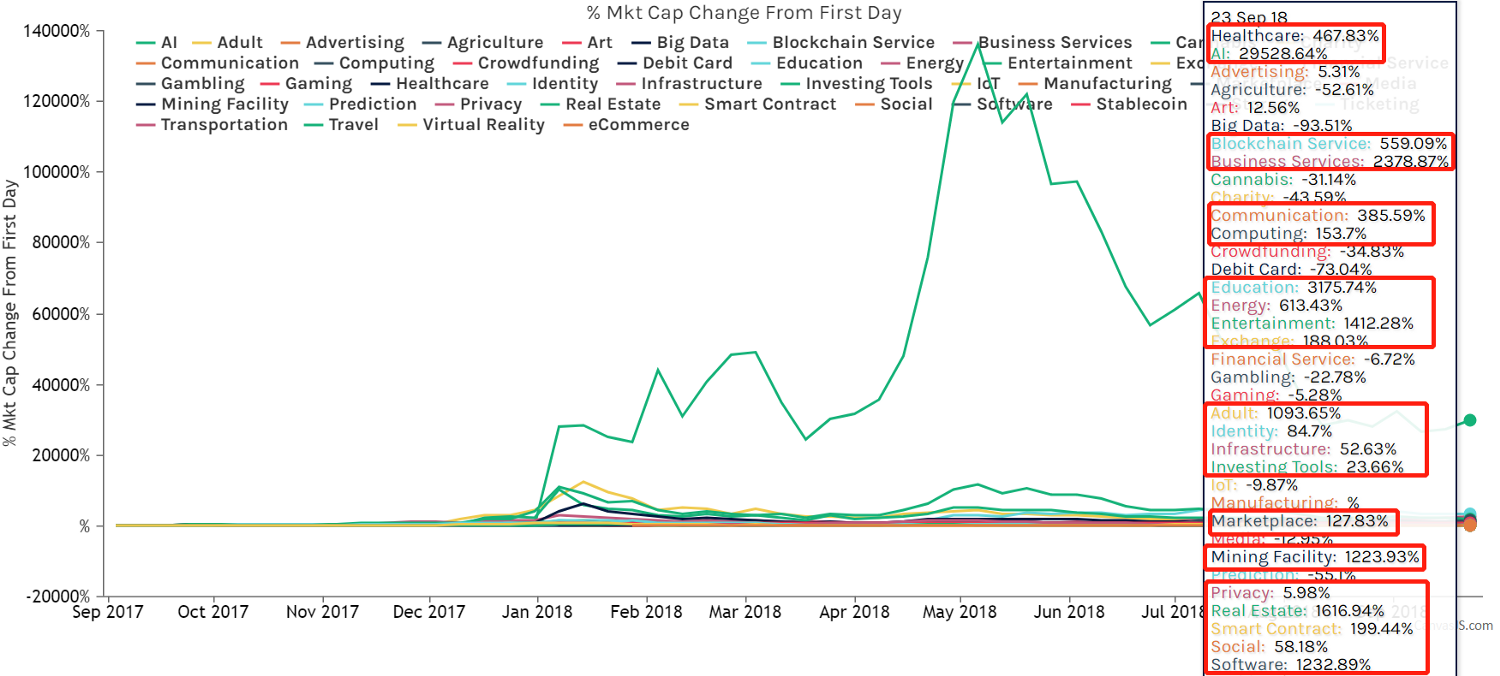
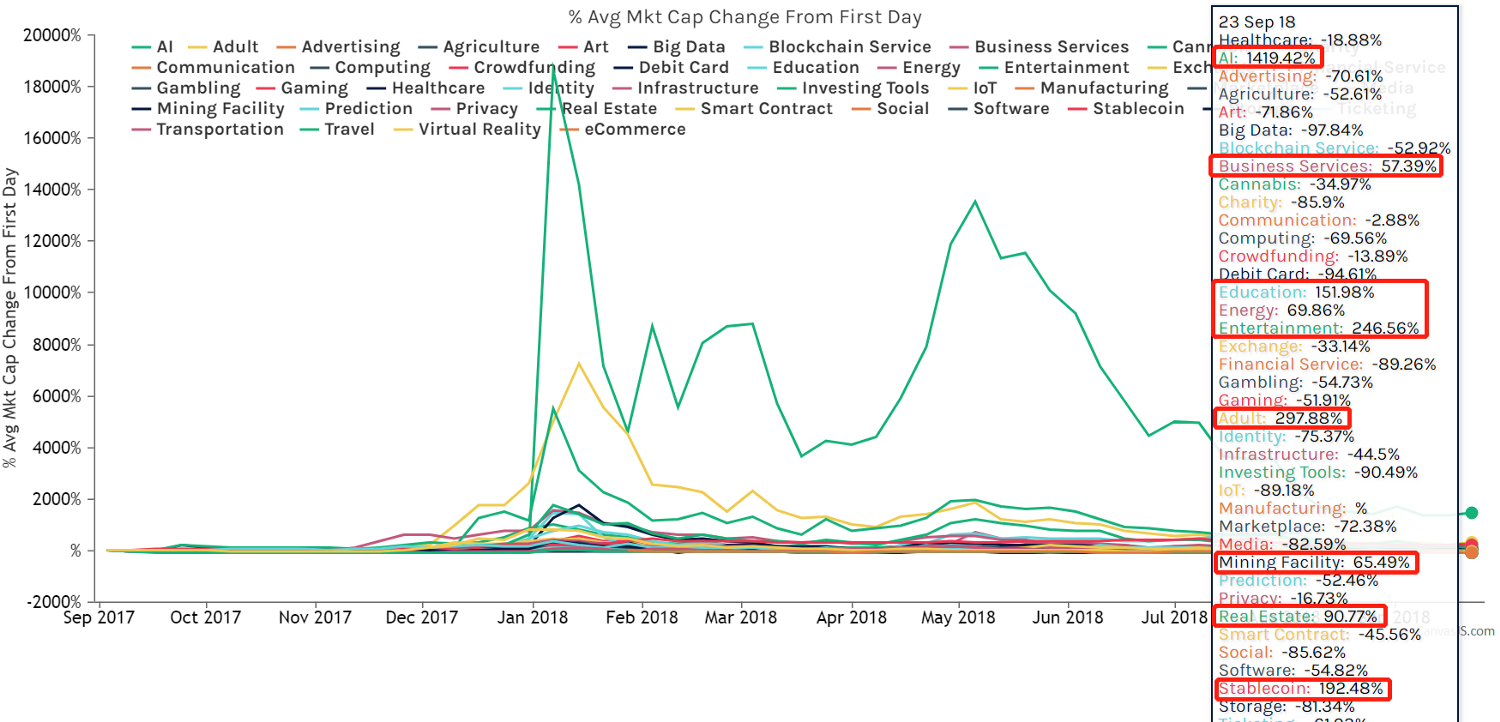
However, most of these growths are not healthy at all. When we come back to the dominant crypto list, we will realize that few cryptos from those categories (except Entertainment) have become dominant on the market. The facts indicate that: the growth in those categories are mostly from the increasing number of new low-market-cap projects, which fluctuate a lot and people call “trash coins”. For example, there was 1 AI-related crypto in September 2017 and 39 cryptos in September 2018. Among these 39 AI-related cryptos, only one crypto once contributed to the top 95% market cap.
On the contrary, if we look into the % average market cap change from September 03, 2017 for the dominant cryptos, we will find that
(1) 9 dominant Privacy cryptos have achieved a 17.46% growth, and only 6 new Privacy cryptos were introduced (from 22 to 28) in the past year;
(2) 3 dominant Entertainment cryptos have achieved a 544.25% growth, and 37 new Entertainment cryptos were introduced (from 11 to 48) in the past year;
(3) 10 dominant Exchange cryptos have achieved a 29.35% growth, and 43 new Exchange cryptos were introduced (from 13 to 56) in the past year;
(4) The market caps of dominant IoT cryptos and Financial Services actually decreased in the last year;
(5) The dramatic growth of dominant Healthcare crypto was from one crypto (Dentacoin).
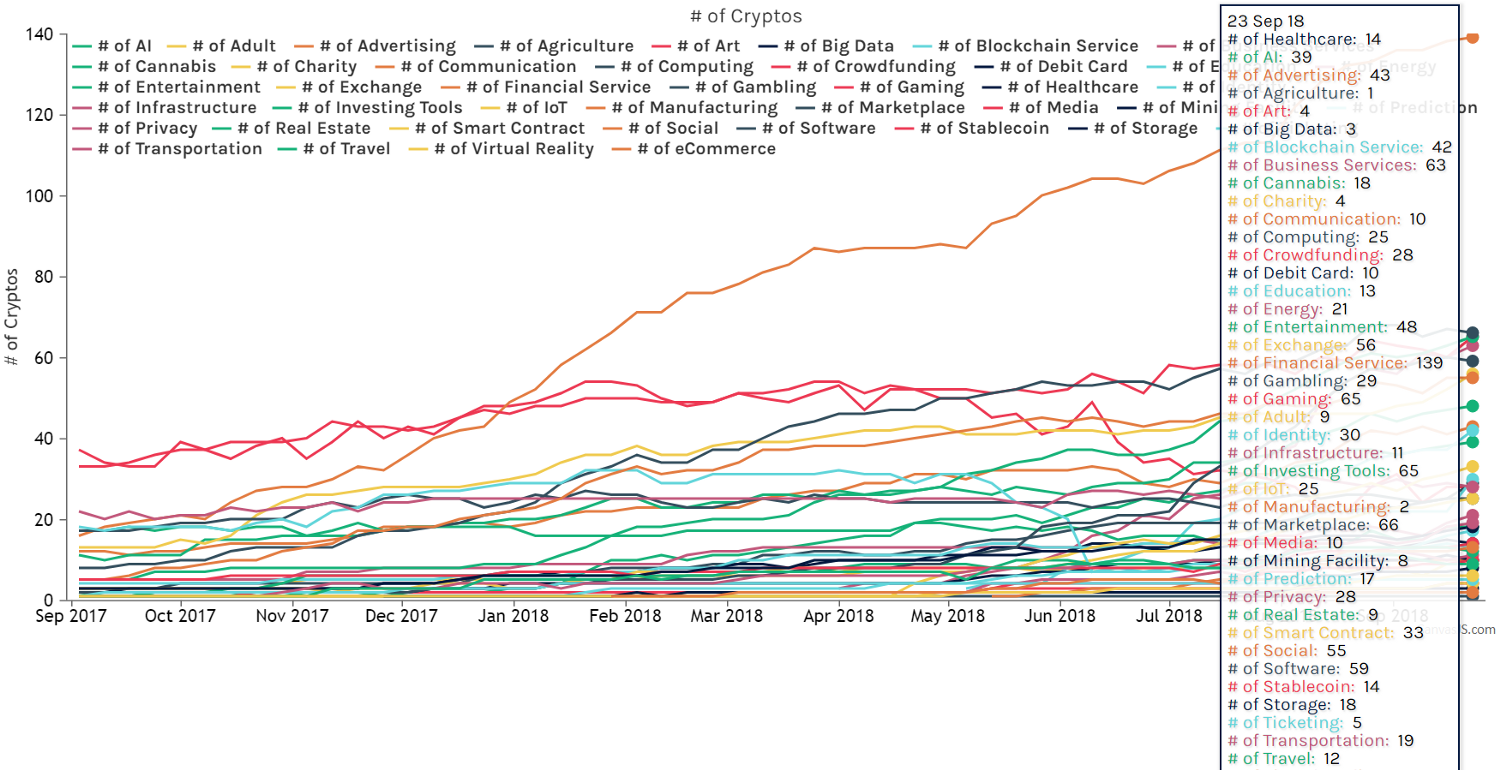
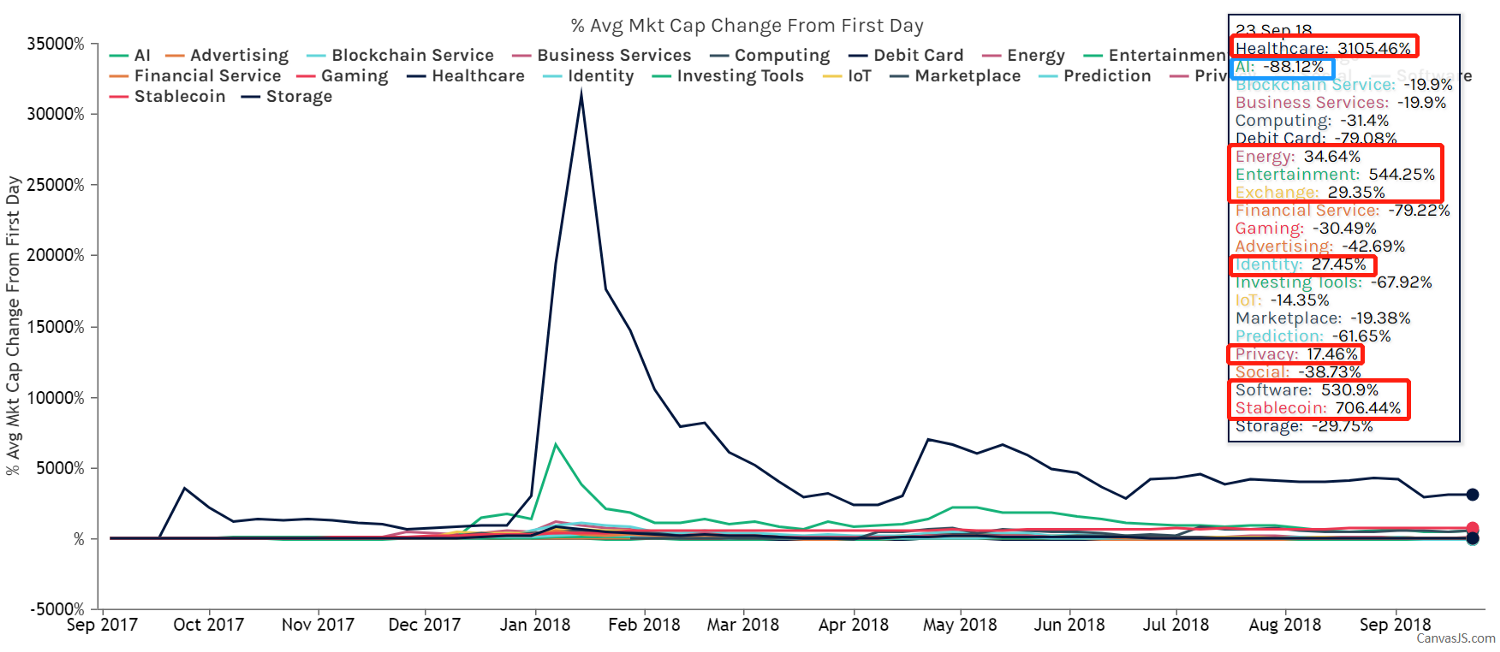
From this growth analysis, we can not only see the quality of growths in different categories but also further confirm that Privacy cryptos are having a healthier than the other categories since: (1) the growth were led by 9 dominant cryptos instead of one or two; (2) the growth was not contributed by an increasing number of new cryptos.
Conclusions
- Not every crypto equals. 5% (165) of the 3,317 cryptos are dominating 95% of the total market cap. Among the 165 dominant cryptos, most of them are from Exchange, Financial Services, Privacy, Marketplace, Gaming, Computing, and Investing Tools.
- Privacy matters. Privacy cryptos are outperforming most of the other categories in total market cap, average market cap, and number of dominant cryptos. Moreover, the growth in Privacy category is healthier than that of the other categories.
- A better Stablecoin is needed. Stablecoins are growing dramatically while certain concerns such as single-point failure have not been fully addressed.
- Chase the healthy growth only. Most of the growth happened in the categories during the last year came from either the growth of one or two dominant cryptos or an increasing number of new low-market-cap cryptos. These growths have little value, while we should only favor the healthy growths.
This research project is completed through a collaboration between Fan Wen at Yale SOM and Josh Liggett at OurCrowd.
Disclaimer: The article is not, and should not be regarded as “investment advice” or as a “recommendation” regarding a course of action, including without limitation as those terms are used in any applicable law or regulation.
Appendix
Full list of the dominant cryptos, as of September 27, 2018
Token (85): Augur, MaidSafeCoin, Golem, SingularDTV, Gnosis, Basic Attention Token, DigixDAO, Ardor, Iconomi, Tether, Veritaseum, Status, MCAP, OmiseGO, TenX, Populous, Civic, Metal, 0x, Binance Coin, Nebulas, Gas, Kyber Network, SALT, Waltonchain, ChainLink, Power Ledger, ICON, VeChain, WAX, FunFair, KuCoin Shares, Dragonchain, Kin, Dentacoin, Dent, Loopring, Ethos, QASH, Request Network, Substratum, Aion, aelf, RChain, Cobinhood, Maker, Quantstamp, Cindicator, IOST, Zilliqa, Pillar, Revain, SingularityNET, Polymath, Storm, Ontology, Mithril, Centrality, Nucleus Vision, Wanchain, Monaco, Bancor, Cortex, Gifto, Loom Network, Fusion, WaykiChain, CyberMiles, BnkToTheFuture, All Sports, Matrix AI Network, Nexo, Nuls, Holo, iExec RLC, DeepBrain Chain, MOAC, Theta Token, Bibox Token, Dropil, Decentraland, Pundi X, Aurora, PayCoin, Tether
Coin (70): Bitcoin, Litecoin, Ripple, Peercoin, Auroracoin, BitShares, Dogecoin, Dash, Ethereum, NEM, Steem, Ethereum Classic, Monero, Zcash, PIVX, Stratis, BitConnect, Decred, Factom, Stellar, Waves, Bytecoin, GameCredits, DigiByte, IOTA, Komodo, NEO, Nxt, EOS, Qtum, Bitcoin Cash, Hshare, Ark, Nexus, Cardano, TRON, MonaCoin, Vertcoin, Bitcore, Bitcoin Gold, Verge, Nano, ZCoin, Electroneum, Syscoin, ReddCoin, Experience Points, BitcoinDark, SmartCash, ZClassic, GXChain, Enigma, Emercoin, Neblio, Cryptonex, Particl, Bitcoin Diamond, Elastos, Bitcoin Private, Skycoin, Game.com, DNotes, Achain, Huobi Token, ZenCash, True Chain, MyBit Token, XRP, Tezos, Metaverse ETP
PoW (43): Bitcoin, Litecoin, Peercoin, Auroracoin, Dogecoin, Dash, Ethereum, Ethereum Classic, , Monero, Zcash, BitConnect, Decred, Bytecoin, Siacoin, GameCredits, DigiByte, Lisk, Komodo, Bitcoin Cash, Hshare, MonaCoin, Vertcoin, Bitcore, Bitcoin Gold, Verge, ZCoin, Syscoin, Experience Points, BitcoinDark, ZClassic, Enigma, Emercoin, Cryptonex, Bitcoin Diamond, Bitcoin Private, , Game.com, DNotes, ZenCash, True Chain, MyBit Token, Metaverse ETP
PoS (33): Peercoin, BitShares, Dash, Steem, PIVX, Stratis, BitConnect, Decred, Factom, Waves, Lisk, Komodo, NEO, Nxt, EOS, Qtum, Hshare, Ark, Nexus, Cardano, TRON, Nano, ReddCoin, Experience Points, BitcoinDark, SmartCash, Emercoin, Neblio, Particl, Wanchain, WaykiChain, Achain, Tezos
Exchange (10): BitShares, 0x, Binance Coin, Kyber Network, ICON, KuCoin Shares, Loopring, Cobinhood, Wanchain, Huobi Token
Financial Service (9): OmiseGO, TenX, Metal, SALT, Request Network, Wanchain, Nexo, Bibox Token, Pundi X
Privacy (9): Monero, Zcash, PIVX, Bytecoin, Verge, ZCoin, ZClassic, Particl, ZenCash
Marketplace (8): Populous, WAX, Syscoin, Particl, SingularityNET, Ontology, Centrality, CyberMiles
Gaming (7): GameCredits, WAX, FunFair, Experience Points, Mithril, Loom Network, Decentraland
Computing (6): Golem, Substratum, aelf, Ontology, iExec RLC, DeepBrain Chain
Investing Tools (6): Iconomi, Cindicator, Polymath, Bancor, BnkToTheFuture, Dropil
AI (4): SingularityNET, Cortex, Matrix AI Network, DeepBrain Chain
Identity (4): Civic, ICON, Syscoin, Metaverse ETP
Software (4): ChainLink, Centrality, Holo, Pundi X
Social (4): Steem, ReddCoin, Mixin, Loom Network
Entertainment (3): SingularDTV, TRON, Theta Token
Storage (3): Siacoin, GXChain, Dropil
Advertising (2): Basic Attention Token, Mithril
IoT (2): IOTA, Waltonchain
Prediction (2): Augur, Gnosis
Blockchain Service (1): Aurora
Business Services (1): Aurora
Crowdfunding (1): PayCoin
Debit Card (1): TenX
Energy (1): Power Ledger
Healthcare (1): Dentacoin
Stablecoin (1): Tether
Uncategorized (3): The DAO, Round, Byteball Bytes